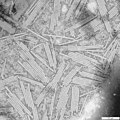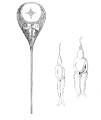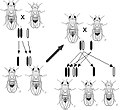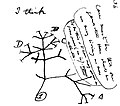Portal:Biology
Introduction
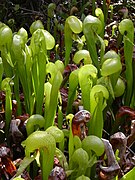

Biology is the scientific study of life. It is a natural science with a broad scope but has several unifying themes that tie it together as a single, coherent field. For instance, all organisms are made up of at least one cell that processes hereditary information encoded in genes, which can be transmitted to future generations. Another major theme is evolution, which explains the unity and diversity of life. Energy processing is also important to life as it allows organisms to move, grow, and reproduce. Finally, all organisms are able to regulate their own internal environments.
Biologists are able to study life at multiple levels of organization, from the molecular biology of a cell to the anatomy and physiology of plants and animals, and evolution of populations. Hence, there are multiple subdisciplines within biology, each defined by the nature of their research questions and the tools that they use. Like other scientists, biologists use the scientific method to make observations, pose questions, generate hypotheses, perform experiments, and form conclusions about the world around them.
Life on Earth, which emerged more than 3.7 billion years ago, is immensely diverse. Biologists have sought to study and classify the various forms of life, from prokaryotic organisms such as archaea and bacteria to eukaryotic organisms such as protists, fungi, plants, and animals. These various organisms contribute to the biodiversity of an ecosystem, where they play specialized roles in the cycling of nutrients and energy through their biophysical environment. (Full article...)
Selected article -

An ecosystem (or ecological system) is a system that environments and their organisms form through their interaction. The biotic and abiotic components are linked together through nutrient cycles and energy flows.
Ecosystems are controlled by external and internal factors. External factors such as climate, parent material which forms the soil and topography, control the overall structure of an ecosystem but are not themselves influenced by the ecosystem. Internal factors are controlled, for example, by decomposition, root competition, shading, disturbance, succession, and the types of species present. While the resource inputs are generally controlled by external processes, the availability of these resources within the ecosystem is controlled by internal factors. Therefore, internal factors not only control ecosystem processes but are also controlled by them. (Full article...)
Selected picture -
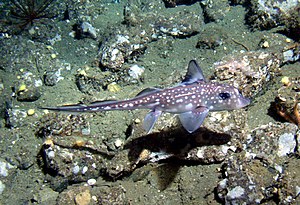
Chimaeras are cartilaginous fish in the order Chimaeriformes, known informally as ghost sharks, ratfish, spookfish, or rabbitfishes. They grow up to 150 cm (4.9 ft) in length, and have elongated, soft bodies, with a bulky head and a single gill-opening. For defense, most chimaeras have a venomous spine located in front of the dorsal fin. At one time a "diverse and abundant" group (based on the fossil record), their closest living relatives are sharks, though in evolutionary terms they branched off from sharks nearly 400 million years ago and have remained isolated ever since, typically confined to deep water.
Major topics
Selected biography -
Daisy Yen Wu (Chinese: 吴严彩韵, 12 June 1902 – 27 May 1993) was the first Chinese woman engaged as an academic researcher in biochemistry and nutrition. Born into a wealthy industrial family in Shanghai, from a young age she was tutored in English and encouraged to study. She graduated from Nanjing Jinling Women's University in 1921 and then studied in the United States, graduating with a master's degree in biochemistry from Teachers College, Columbia University in 1923. Returning to China, she became an assistant professor at Peking Union Medical College between 1923 and her marriage at the end of 1924 to Hsien Wu. Collaborating with him, she conducted research on proteins and studied nutrition. After their marriage she continued to assist in the research conducted by Wu as an unpaid staff member until 1928. She and her husband collaborated in writing the first Chinese textbook on nutrition, which remained in print through the 1990s.
While raising their children, Yen Wu recognized that educational opportunities were limited and founded the Mingming School (Chinese: 明明学校) in 1934 to provide a modern comprehensive education for Chinese children. She also raised funds in 1936 to build a school hospital for their alma mater, the Jinling Women's College, and earned a degree in French. In 1949, as her husband was in the United States and unable to return because of the Chinese Communist Revolution, she took the children abroad. Hired as a researcher for the Medical College of Alabama, she resumed collaboration with her husband, until his death in 1959. Moving to New York City in 1960, she conducted research for the United Nations Children's Fund to develop nutritional standards from 1960 to 1964. From 1964 to 1971 she worked as a lecturer and created a reference library for the Institute of Human Nutrition at Columbia University College of Physicians and Surgeons and from 1971 to 1987 she worked at St. Luke's Hospital Center, creating a library for the New York Obesity Research Center. Throughout her life, Yen Wu created numerous scholarships in China, Taiwan, and the United States which bear the name of family members and allow students to further their education. She died in 1993 in Ithaca, New York. (Full article...)
General images -
Did you know -
- ... that seeds of the fossil fruit Suciacarpa have fossil fungi inside them?
- ... that the fossil ant genus Agastomyrma was described from a single queen, and males of the fossil ant Proceratium eocenicum have a hair fringe?
- ... that less than 50 years after being discovered, Heterelmis stephani is now presumed extinct?
- ... that in 1981 Bobbi Campbell became the first person to publicly identify as a person living with HIV/AIDS?
Things you can do
Related portals
Biology portals
Categories

Anatomy - Anthropology - Astrobiology - Biochemistry - Bioengineering - Bioinformatics - Biotechnology - Botany - Cell biology - Conservation biology - Developmental biology - Ecology - Environmental science - Evolutionary biology - Genetics - Mathematical biology - Medicine - Microbiology - Immunology - Molecular biology - Mycology - Neuroscience - Paleontology - Palynology Parasitology - Pharmacology -
Phylogenetics - Physiology - Systems biology - Taxonomy - Toxicology - Virology - ZoologyMore topics
WikiProjects

WikiProjects connected with biology:
A complete list of scientific WikiProjects can be found here. See also Wikispecies, a Wikimedia project dedicated to classification of biological species.
Associated Wikimedia
The following Wikimedia Foundation sister projects provide more on this subject:
-
Commons
Free media repository -
Wikibooks
Free textbooks and manuals -
Wikidata
Free knowledge base -
Wikinews
Free-content news -
Wikiquote
Collection of quotations -
Wikisource
Free-content library -
Wikiversity
Free learning tools -
Wiktionary
Dictionary and thesaurus







